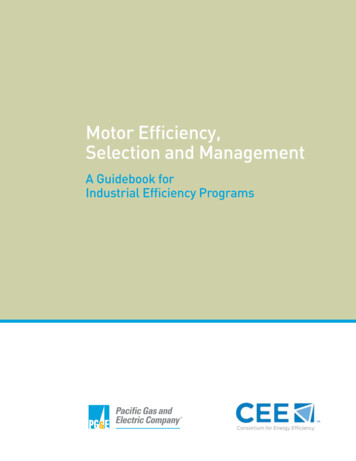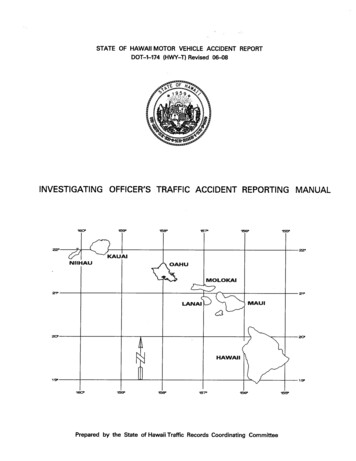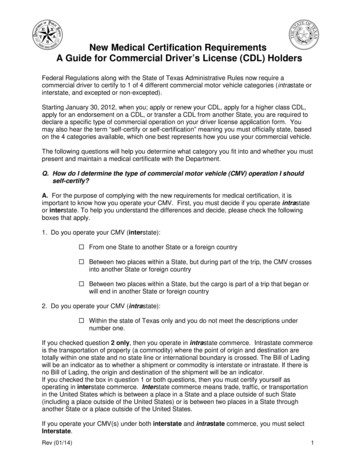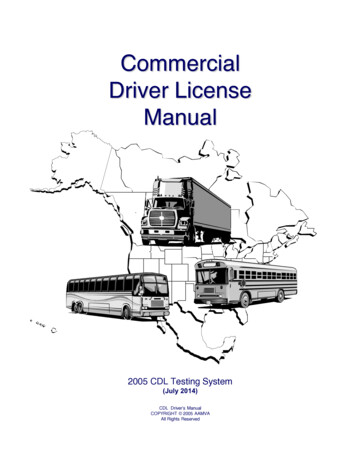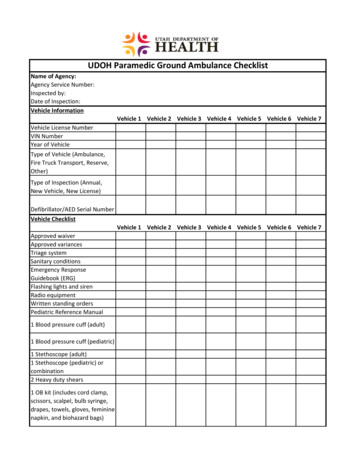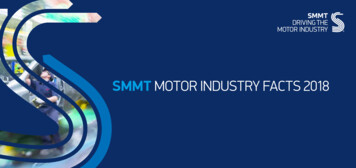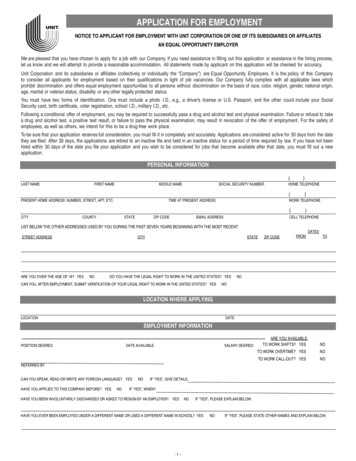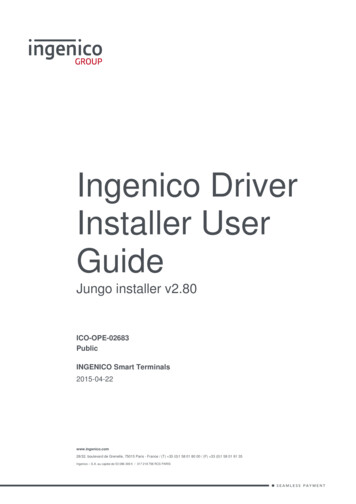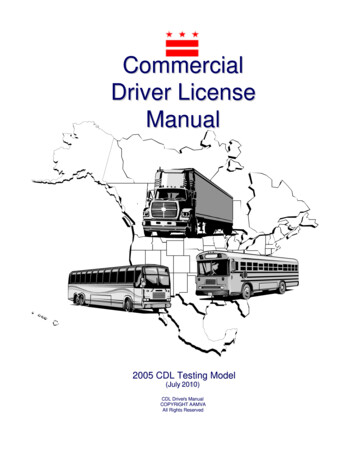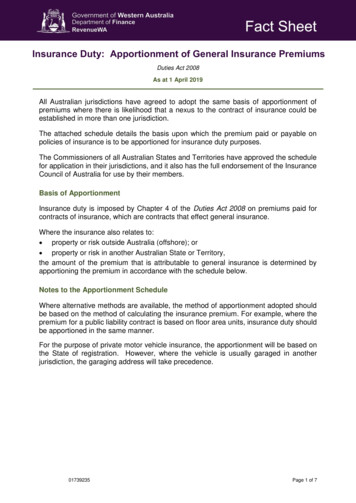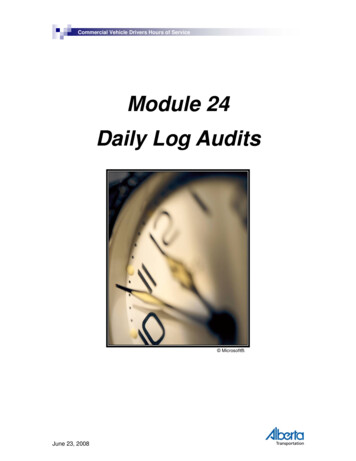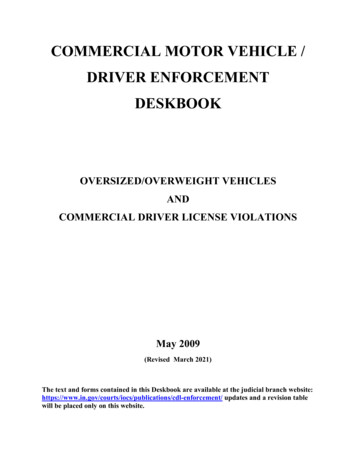
Transcription
COMMERCIAL MOTOR VEHICLE /DRIVER ENFORCEMENTDESKBOOKOVERSIZED/OVERWEIGHT VEHICLESANDCOMMERCIAL DRIVER LICENSE VIOLATIONSMay 2009(Revised March 2021)The text and forms contained in this Deskbook are available at the judicial branch s/cdl-enforcement/ updates and a revision tablewill be placed only on this website.
The initial publication was supported by grant funds awarded by the Federal Motor CarrierSafety Administration (FMCSA) through a Safety Data Improvement Program (SaDIP) grantby Project Number MR-08-18-01-G-00000. This grant was awarded to the Indiana StatePolice Commercial Vehicle Enforcement Division.Subsequent revisions to this material have been prepared by the Special Courts Committee ofthe Judicial Conference of Indiana.
IndexINTRODUCTION. 5OVERWEIGHT AND OVERSIZED VEHICLES . 8Statutory Summary . 8Size Regulations . 8Maximum Width . 8Maximum Height . 9Maximum Length. 9Special Restrictions re: Combined Vehicles (IC 9-20-9) . 10Special Restrictions for Farm Vehicles and Machinery (IC 9-20-10) . 10Special Restrictions for Mobile Homes and Special Tractor-Mobile Home Rigs andRequired Permits (IC 9-20-12, 14 and 15) . 10Weight Regulations . 10General Limits (IC 9-20-4-1 and 23 CFR 658.17) . 10Limits for Garbage Trucks (IC 9-20-11) . 11Exemptions for Farm Commodities (IC 9-20-4-2) . 11Unladed Vehicle Weight - How is it determined? . 11Restriction on Weight Regulation Penalties (IC 9-20-4-3(b)) . 11Heavy Duty Highways (IC 9-20-5). 11Extra Heavy Duty Highways (IC 9-20-5) . 12Bridge, Causeway and Viaduct Weight Restrictions (IC 9-20-7) . 13DEPARTMENT OF REVENUE GENERAL OVERSIZE/OVERWEIGHT PERMITPROVISIONS. 14DETENTION AND IMPOUNDMENT OF OVERWEIGHT VEHICLES . 15Detention (IC 9-20-18-3) . 15Impoundment . 15Sale (IC 9-20-18-8) . 16PENALTIES . 16Court Proceedings and Statutory Exceptions and Defenses . 16Penalty Chart . 17Notification to the Indiana Department of Revenue [IC 9-20-18-9 (b)] . 17Unsecure Loads (IC 9-20-18-14) . 18Civil Penalties Imposed by the Department of Revenue (IC 9-20-18-14.5) . 18Where Does the Money Go?. 18
INTERSTATE COMPACT APPLICABILITY (IC 9-20-18-16) . 18PROCEEDINGS CONCERNING OVERWEIGHT VEHICLES . 19OVERWEIGHT VEHICLES PROCEEDING CHECKLIST . 20ORDER DETAINING OVERWEIGHT VEHICLE . 21ORDER/JUDGMENT . 22COMMERCIAL DRIVER’S LICENSE (CDL) . 23IS A COMMERCIAL DRIVER’S LICENSE REQUIRED? . 24FEDERAL MOTOR CARRIER SAFETY ACT . 25What is a Commercial Driver License (CDL)? . 26Compliance with Federal Motor Carrier Safety Act . 28Use of Seat Belts in a Commercial Motor Vehicle . 28Hardship / Probationary / Restricted Licenses . 29Diversion Programs or Agreements to Withhold Prosecution . 30Commission of a Felony while Operating a Vehicle . 30CDL PENALTY CHARTS FOR VIOLATIONS COMMITTED IN INDIANA . 31Major Offense Disqualifications . 31Serious Traffic Offenses . 32Railroad – Highway Crossing Offenses . 33Violation of Out of Service Orders . 34EXAMPLES OF FINES AND FEES COLLECTED FOR COMMERCIAL VEHICLEVIOLATIONS . 34
INTRODUCTIONObservation of the motor vehicles using Indiana roads, highways and interstates readilydemonstrates the transition that has occurred in recent decades with regard to shipment andmovement of commerce within the state and the nation. American commerce which used to travelpredominately by rail now relies heavily upon ground transportation supplied by heavy trucks of allsizes, shapes and configurations. Truck usage of the highway infrastructure has become so dense thatconsideration has been given to the construction of “truck only” roadways paralleling interstatehighways.The most recent survey conducted by the United States Census Bureau revealed that in 1997there were at least 4.7 million registered and licensed large trucks, i.e. those weighing 10,000 poundsor more. Approximately 8.2% (386,000) of all trucks transport hazardous materials in quantitiesgreat enough to require display of a placard warning of the nature of the cargo. Each day of the yearshipments of hazardous materials exceed 800,000.Hazardous cargos can appear to be relatively innocuous; e.g. hair spray, perfume. However,many shipments contain materials and liquids posing a threat to the environment and populace; e.g.bulk shipments of caustic, poisonous, flammable, explosive or radioactive materials. According tothe Census Bureau, hazardous material shipments account for 11% of all cargo tonnage.Rural (state) highways are the most common location of truck crashes (both fatal andnonfatal) and account for about 60% of all crashes. Highways marked with United States Routenumbers account for about 40% of all crashes. The average cost of a truck crash for 2001 – 2003,adjusted to 2005 dollars, exceeded 91,000.00. When a truck carrying a hazardous material cargo isinvolved in a crash, a release of the cargo and a death occurs in about one-third of such crashes.Every time a truck is involved in a crash, the impact ripples through the economy as well asthe lives of the participants. Each accident may involve a variety of direct costs:1. cargo damage2. vehicle damage3. injury(s) costs4. medical costs5. loss of revenue6. administrative costs7. police report8. effect on insurance costs9. effect on workmen's compensation insurance costs10. towing costs11. damaged vehicle storage.
Accidents also result in other costs which are hidden:1. lost clients/customers2. lost sales3. meetings missed4. salaries paid to employees in accident5. lost time at work6. cost to hire/train replacement employees7. supervisor's time8. loss of personal property9. replacement vehicle rental10. damaged equipment downtime11. accelerated depreciation of equipment12. accident reporting13. medical costs paid by company14. poor public relations/publicity15. increased public relations costs16. government agency cost.By way of example, a motor carrier that experiences an “average accident” described abovemust generate an additional 4.55M in revenue, assuming an average profit margin of 2%, to offsetthe cost of the accident.As the United States moved from reliance upon rail transportation to trucks, the interstatehighway system was built and completed. Maintenance and repair of these, as well as other publichighways, have been impacted by the increased volume of truck and car traffic.Overweight and oversized vehicles cause damage to the road infrastructure while carriersattempt to earn greater revenue from the transportation of a single load. Road damage can be bothimmediately visible as well as observable only with the passage of time.Almost one-third of all trucks using the highway system are loaded beyond legal limits(overweight). The continued passage of overloaded trucks on a roadway results in roads that areworn out in about 80% of the otherwise expected life based upon the design standards. A 1990federal government study estimated that overloaded trucks caused pavement damage well in excess of 200M per year. Special Report 225: “Truck Weight Limits: Issues and Options”, TransportationResearch Board, National Research Council, Washington, D.C., 1990.A correlation also exists between overloaded trucks and failure to comply with safetyregulations. Thirty percent of trucks on the highways have safety deficiencies substantial enough toplace the truck and/or the driver out of service. Seventy percent of overloaded trucks are both safetyand driver regulation deficient. Thus, overloaded trucks are three times as likely to be violatingsafety regulations as general truck traffic. Taylor, Brian, Bergan, Dr. Art, Lindgren, Norm andBerthelot, Dr. Curtis, “The Importance Of Commercial Vehicle Weight Enforcement In Safety AndRoad Asset Management”, Traffic Technology International 2000, Annual Review, January, 2000,pp. 234-237.6
Thus, Indiana has both a fiscal as well as humanitarian interest in thorough and forcefulenforcement of its laws related to overweight and oversized commercial vehicles and those who arelicensed as operators. However, issues related to the operation of vehicles on Indiana highways thatviolate laws concerning weight and size restrictions and the operation of commercial motor vehiclesare not presented to most judges with a frequency that engenders immediate recollection of theintricacies involved. Complications regarding these cases arise from differing jurisdictions(Department of Revenue, Bureau of Motor Vehicles and Federal Motor Carrier Safety Act).The purpose of these materials is to acquaint judges who are seldom faced with these types ofviolations with the information needed to accurately dispose of the issues as well as to provideassistance for those who are confronted with issues that arise in these areas with greater frequency.7
OVERWEIGHT AND OVERSIZED VEHICLESThe Indiana Department of Revenue administers all restrictions concerning weight and sizerestrictions and special notification must be provided.Statutory SummaryIC 9-20-1 prohibits owners and operators of motor vehicles from exceeding statutory limitsupon vehicle weight and size while driving upon Indiana highways. The Indiana Departmentof Transportation may prohibit the operation of vehicles or impose weight restrictions uponvehicles for a period up to 90 days within a year when serious damage or destruction wouldoccur due to road deterioration or weather or climate conditions. Similarly, local authoritiespossess the same authority concerning streets and highways that are not part of the statehighway system.IC 9-20-2 establishes width and height exemptions for:1. Vehicles:a. engaged in highway construction and used on roads under constructionnot open to public use,b. operated under approved permit during highway construction orc. registered or exempted recovery vehicles moving a disabled vehiclethan 50 miles andandless2. Vehicles/machinery not on interstate highways:a.used by the State of Indiana, county or municipal in highwayconstruction or maintenance,b. agricultural implements used during farm operations or constructedsomovement would not cause material damage to highways,c. farm drainage machinery and farm vehicles loaded with farmproduct andd. firefighting apparatus owned or operated by a political subdivisionorvolunteer fire department.Size RegulationsIC 9-20-3 regulates the length, width and height of vehicles and their loads that may beoperated upon Indiana highways.Maximum Width(IC 9-20-3-2): (except for federal exemption)Load may not extend more than 6" beyond fender line onthe right side (IC 9-20-3-5).Exemptions:88' 6"
1. Machinery or equipment used in utility construction or maintenanceif the violation is the result of oversize tires or2.recreational vehicles with manufacturer installed rear view mirrorsextending only as far as necessary to afford the required field of view.Maximum Height(IC 9-20-3-3):13'6"Maximum Length(IC 9-20-3-4 unless otherwise specified)1. single vehicle:If equipped with permanently installed specializedequipment used for lifting, reaching, pumping, or spraying,an additional 5’ for overhang of the equipment is allowed.2. recreational vehicle or railroad construction, reconstructionor maintenance vehicle:40'45'3. buses (IC 9-20-8-2):a. articulating public transportation busb. conventional school busc. all others4. garbage truck-trailer and truck-wagon combinations(IC 9-20-11-5)65'42'45'68'5. truck-tractor/semitrailer-trailers combinations (IC 9-20-13)a.b.c.d.semitrailer or trailer units (doubles/triples)grandfathered semitrailers (IC 9-20-13-4 and 23 CFR 658)semitrailercombinations - truck-tractor semitrailer semitraileror truck-tractor semitrailere. maxi cube cargo unitf. maxi cube cargo unit28' 6"48' 6"53'None65'34'6. vehicle used by railroad companies in connection with railroad construction,reconstruction, maintenance40’9
Special Restrictions re: Combined Vehicles (IC 9-20-9)This chapter contains length restrictions applicable to a wide variety of methods bywhich vehicles and boats are delivered by transport operators through the use ofvarious coupling and towing techniques. Depending upon the particular type andcombination, length restrictions vary from 60' to 80'.Special Restrictions for Farm Vehicles and Machinery (IC 9-20-10)Farm tractors may not draw more than two wagons or implements upon a highway.Farm wagons and implements must conform to all laws regarding use of highways.Special Restrictions for Mobile Homes and Special Tractor-Mobile Home Rigsand Required Permits (IC 9-20-12, 14 and 15)This chapter has restrictions concerning transportation of mobile homes.Weight RegulationsIC 9-20-4 provides general weight restrictions for vehicles upon Indiana highways.Toll Road weight limits are promulgated by the Indiana Department of Transportation.Interstate highway weight restrictions are set forth in 23 CFR 658.17.General Limits (IC 9-20-4-1 and 23 CFR 658.17)1. total loaded gross weight formula for 2 or more consecutive axles –overall gross weight limit of 80,000 pounds,2. axle groupa. 34,000 pounds on a tandem axle,b. 20,000 pounds on an individual axle,3. maximum wheel weight (laden or unladen) of 800 lbs. per inch widthof tire, measured between the rim flanges, or an axle weight in excess of20,000 pounds.Ind. Code § 9-20-4-1 allows for the grand-fathering of vehicles that would havereceived a greater weight allowance under the rules in place on January 4, 1975 thanallowed under the bridge formula. This allows them to carry the same weights as priorto this date. Those weights are:Gross weight with load not to exceedSingle axle (800 lbs per inch of rim width)Tandem axle1073,280 lbs.18,000 lbs.32,000 lbs.
These weights are used to determine the gross weight of these shorter vehicles, butprovide them the greater of the axle weights per IC 9-20-4-1(a).Limits for Garbage Trucks (IC 9-20-11)1. single axle: 24,000 pounds,2. tandem axle group: 42,000 pounds for state highways but not interstatehighways. Unladen garbage trucks are subject to thesame axlelimitations as all other trucks.Exemptions for Farm Commodities (IC 9-20-4-2)Farm commodities being transported from the point of production to the first point ofdelivery where the commodities are weighed and title to the commodities is transferredare exempt from the penalty for being overweight or payment of penalty before movingif the gross limit is not exceeded by more than 10% except with regard to bridge limitviolations, sections of highways or interstate highway transportation. Farmcommodities include logs, wood chips, bark, sawdust, and bulk milk.Unladed Vehicle Weight - How is it determined?Pursuant to IC 9-20-4-3(a), the weight is fixed as the weight declared in theapplication for registration.Restriction on Weight Regulation Penalties (IC 9-20-4-3(b))Penalties for violation of load limits may not be assessed unless the actual scale weightexceeds 1 ½% of the vehicle registered weight including load.Heavy Duty Highways (IC 9-20-5)The Indiana Department of Transportation may designate a highway as “heavy duty”or “extra heavy duty” and establish maximum weights.“Heavy duty” highway limitations are:1. loaded or unladen - 800 pounds per inch width of tire, measuredbetween the flanges of the rim, or an axle weight in excess of 22,400pounds,2. total weight concentrated on the roadway surface from any tandemgroup - 18,000 pounds for each axle of the assembly andaxle3. total gross weight, with load, in pounds of a vehicle or combinationvehicles 80,000 pounds.of11
Extra Heavy Duty Highways (IC 9-20-5)“Extra heavy duty” highways are listed in IC 9-20-5-4 and have special limitations.The total gross weight, with load, of a vehicle or combination of vehicles operatedwith a special weight permit on these highways is 90,000 pounds.Maximum size and weight limits on “extra heavy duty” highways with special weightpermit (IC 9-20-5-5):1.2.total gross weight, with load, of a vehicle orcombination of vehicles operated with a specialweight permitexcept for portions of State Road 3,U.S. 20, State Road 9 which is limited to90,000 lbs, or except Highway 912 near DickeyRoad and Riley Road in East Chicago134,000 lbs264,000 lbsmaximum size and weight limits with specialweight permit (IC 9-20-5-5):a. loaded or unladen - per inch width oftire, measured between the flanges of the rim800 lbs.b. single axle18,000 lbs.c. an axle combination - per axle(exception - 1 tandem group may be16,000 lbs. per axle or a total of 32,000 lbs.)13,000 lbs.d. total gross weight, with load, of anyvehicle or combination of vehiclesexcept as provided in section IC 9-20-22134,000 lbs.e. axle combination spacing may not beless than3' 6"f. axle spacing between each axle oraxle combination not be less than8'.g. for vehicle operating under Highway 912exception, loaded or unladen – per inchwidth of tire, measured between the flanges ofthe rim1,650 lbs.h. for vehicle operating under Highway 912exception, single axle65,000 lbs.12
Special Weight Permits are required and must be displayed as required byIC 9-20-5-7 for transportation of vehicles with a total gross weight between80,000 pounds and 264,000 pounds on “extra heavy duty” highways.Both the Indiana Department of Transportation and local authorities that havejurisdiction over a highway or street and responsibility for repair and maintenance areauthorized to issue special and emergency permits. These permits allow thetransportation of vehicles and loads which exceed otherwise applicable weight, sizeand length limitations. See IC 9-20-6.Bridge, Causeway and Viaduct Weight Restrictions (IC 9-20-7)Provides that the Indiana Department of Transportation and a local authority withresponsibility for the repair and maintenance of a bridge, causeway or viaduct mayreduce the weight limits set for highways, heavy duty highways and extra heavy dutyhighways if they determine that the maximum load is greater than the bridge,causeway, or viaduct can sustain without serious damage or with safety to the vehicle.Penalties for exceeding the weight limit on a bridge, causeway or viaduct are the sameas for operating an overweight vehicle upon a highway.13
DEPARTMENT OF REVENUE GENERAL OVERSIZE/OVERWEIGHT PERMIT PROVISIONS14
DETENTION AND IMPOUNDMENT OF OVERWEIGHT VEHICLESDetention (IC 9-20-18-3)An overweight vehicle must be detained until its weight is reduced or distributed to complywith the limitation involved. During detention, the vehicle must be kept in the custody of theapprehending officer and may only be moved at the officer’s direction.IC 9-20-18-3(a) and (b).The operator may post bond as set by the Court. Once bond has been posted and the vehicleweight reduced to the legal limit, the vehicle must be released by Court order.IC 9-20-18-3(c).ImpoundmentIf bond is not posted, the Court may direct the apprehending officer to impound the propertyuntil bond has been posted or all fines and costs have been paid or stayed. IC 9-20-18-3(d).Impoundment of a portion of the cargo of an impounded vehicle is not authorized.IC 9-20-18-5.Unauthorized movement of an impounded vehicle is a Class A infraction.IC 9-20-18-4.An impounding officer is required to give the operator of the overweight vehicle reasonableopportunity to notify the shipper or person with monetary interest in the cargo or vehicle of thecargo location. IC 9-20-18-6.The Court must determine the extent of liability of the driver, carrier, shipper or other partyshown liable. As a matter of defense, a party may show they could not reasonably have knownthe actual weight of the load or that they did not have access or control of the loading of thevehicle. However, if a person who is an owner, a driver, a carrier or a shipper specifically ordirectly orders or assigns a particular shipment to be loaded the person shall be considered tohave had control of the loading and a showing of knowledge of the over weighted load affixesliability to the person. A person who has loaded a shipment has control of the loading and ashowing of knowledge of the over weighted load results in liability to the person if they are selfemployed. If the person loading a shipment is not self-employed, then liability affixes to theperson's employer jointly and severally with the driver of an overweight vehicle. IC 9-20-18-7.An owner of a vehicle or combination of vehicles involved in a case who has been found jointly orseverally liable, shall be given ninety (90) days to pay the liability assessed by the court. Duringthe ninety (90) day period, the Court may continue the impoundment of the equipment until allfines and costs are paid. If the fines and costs are not paid within the ninety (90) days, the Courtmay order the property sold to pay the fines and costs.IC 9-20-18-7.15
Sale (IC 9-20-18-8)An order of sale may include an apportionment of fines and costs among the parties and/orestablish a civil right of recovery by the owner of the property to be sold against any otherparties the Court finds liable for apportioned shares.The procedure for sale is the same as for abandoned property. The impounding officer initiatesthe action necessary for the sale of the impounded property under the laws concerning the sale ofabandoned vehicles. Expenses incurred in the storage and selling of a vehicle or combination ofvehicles shall be deducted from the sale proceeds and any amount remaining shall be forwardedto the owner by registered mail. The person conducting the sale may give a bill of sale to apurchaser and the Bureau of Motor Vehicles may issue a certificate of title based on the bill ofsale.All sales are subject to all liens of record or recorded on the title and a mechanic's possessorylien.PENALTIESCourt Proceedings and Statutory Exceptions and DefensesViolations of size and weight limitations by operation of a vehicle or combination of vehicles(IC 9-20-4 and 9-20-5) or a garbage truck (IC 9-20-11) are a continuing offense. The venuefor prosecution is in a county in which the unlawful operation occurred. Once a conviction oracquittal occurs in one county, a prosecution may not be brought in another county. IC 9-2018-1.All violations under IC 9-20 except for weight violations of 5,000 pounds or more are Class CInfractions and, in addition to a fine, the Court may suspend the vehicle registration for a periodnot to exceed 90 days. IC 9-20-18-12(a) & (d).IC 9-20-18-12(c) creates an exception from conviction applicable to all highways exceptinterstate highways if the weight violation is less than 1,000 pounds. IC 9-20-18-7(b)establishes a defense if the party can show they could not reasonably have known the actualweight of the load or did not have access to or control of the loading of an over weighted load.Weight violations greater than 5,000 pounds but less than 10,000 pounds are Class BInfractions. If the weight violation exceeds 10,000 pounds, the violation is a Class AInfraction. IC 9-20-18-12(b).In all weight violation cases, the Court may recommend a chauffeur’s license suspension ifthe violation was committed knowingly. IC 9-20-18-12(e).16
Penalty ChartInfractionCPenalty RangeFine: 1.00 - 500.00Suspend vehicle registration 1 – 90 daysRecommend license suspension (offense committed knowingly)BFine: 1.00 - 1,000.00Suspend vehicle registration 1 – 90 daysRecommend license suspension (offense committed knowingly)AFine: 1.00 - 10,000.00Suspend vehicle registration 1 – 90 daysRecommend license suspension (offense committed knowingly)Notification to the Indiana Department of Revenue (IC 9-20-18-9(b))Immediately upon conviction of a weight violation under IC 9-20-4-1(a), a certified copy ofthe court judgment of conviction must be sent to the Indiana Department of Revenue. Thejudgment must contain the:1. name of the vehicle owner,2. date of violation, and3. amount of the fine imposed.The Revenue Department is required to maintain a record of all convictions and commenceadministrative suspension hearings for multiple violations as provided under IC 9-20-18-9(b).Administrative suspension hearings result upon certification of the required number of weightviolation convictions. Vehicle use of Indiana highways and permits, registration certificatesor certificates of authority issued to a person shall be suspended for convictions within a yearas follows:1.2.3.4.5th conviction . 5 days10th conviction 10 days15th conviction 30 daysEach conviction 15, an additional period of. 5 daysIC 9-20-18-9(a).Once the Revenue Department receives the required number of certifications, a notice to appearand show cause why a suspension should not be assessed is sent by certified mail to the violator.The Department is required to issue a decision within 30 days of the hearing.17
If a private carrier convicted of weight violations is not under the jurisdiction of the Departmentof Revenue, the Department certifies the convictions to the Bureau of Motor Vehicles once therequired number of convictions has been received. The Bureau then issues the show cause noticeto the violator and the Revenue Department conducts the suspension hearing and issues itsdetermination. IC 9-20-18-9(c-f).Unsecure Loads (IC 9-20-18-14)Loads of logs, lumber, pipe, poles, tanks, boilers or other similar objects transported upon apublic street or highway must be secured with metal chains, wire cables, steel strapping orlogistic webbing of synthetic fibers identified concerning strength with compatible hardware tohold the load in place under ordinary traffic or road conditions. Loads or portions of a loadlonger than 10 feet must utilize at least 3 fasteners positioned in the middle and near the frontand end of the load. A violation of this section is a Class C Infraction.Civil Penalties Imposed by the Department of Revenue (IC 9-20-18-14.5)The Indiana Department of Revenue may impose civil penalties with regard to violations afterconducting an administrative hearing not to exceed:1. 500.00 for the first violation by a person who obtains apermit under IC 9-20 and commits a violation there under and 1,000.00 for each subsequent violation, and2. 5,000.00 for each violation resulting
The Indiana Department of Revenue administers all restrictions concerning weight and size restrictions and special notification must be provided. Statutory Summary . IC 9-20-1 prohibits owners and operators of motor vehicles from exceeding statutory limits upon vehicle weight and size while driving upon Indiana highways. The Indiana Department
